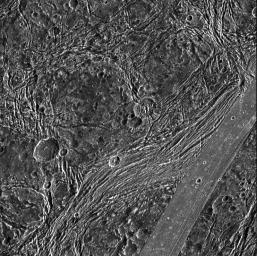
|
Fractures in Nicholson Regio
- Click the image above for a larger view
- Full-Res JPEG (800 x 798) (202.1 kB)
- Full-Res TIFF (800 x 798) (626.8 kB)
Caption:
View of Nicholson Regio on Jupiter's moon, Ganymede, showing heavily fractured dark terrain and a lane of smooth bright terrain. North is to the top of the picture. A smooth, linear plank-like strip of bright terrain cuts across the southeast (lower right) corner of the image. Just west (left) of this is a very heavily fractured lane of dark terrain, curving towards the south. This fractured lane looks bright in lower resolution Voyager images and may be transitional between the older, heavily fractured dark terrain, and younger, less densely cratered bright terrain. The many other fractures visible within the dark terrain probably result from extension in the area. Some of these fractures were focused around weaknesses created by older craters (such as the one just east of the image center).
The sun illuminates the surface from the right. The image, centered at 14 degrees south latitude and 352 degrees longitude, covers an area approximately 144 by 144 kilometers. The resolution is 180 meters per picture element. The image was taken on April 5, 1997 at 6 hours, 31 minutes, 35 seconds Universal Time at a range of 17,842 kilometers by the Solid State Imaging (SSI) system on NASA's Galileo spacecraft.
Background Info:
The Jet Propulsion Laboratory, Pasadena, CA manages the Galileo mission for NASA's Office of Space Science, Washington, DC.
This image and other images and data received from Galileo are posted on the World Wide Web, on the Galileo mission home page at URL http://www.jpl.nasa.gov/galileo/sepo .
Cataloging Keywords:
| Name | Value | Additional Values |
|---|---|---|
| Target | Ganymede | |
| System | Jupiter | |
| Target Type | Satellite | |
| Mission | Galileo | Voyager |
| Instrument Host | Galileo Orbiter | |
| Host Type | Orbiter | Flyby Spacecraft |
| Instrument | Solid-State Imaging (SSI) | |
| Detector | ||
| Extra Keywords | Crater, Grayscale | |
| Acquisition Date | ||
| Release Date | 1998-07-15 | |
| Date in Caption | 1997-04-05 | |
| Image Credit | NASA/JPL/Brown University | |
| Source | photojournal.jpl.nasa.gov/catalog/PIA01613 | |
| Identifier | PIA01613 | |
